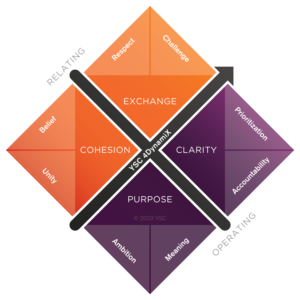Thrust into home working when lockdown hit, leaders we work with across the globe have reported that their teams thrived when stepping up to the immediate challenges. Their teams quickly adjusted to the new setting, embraced the novelty of virtual working and rallied around to deliver against the urgent issues. However, what began as a sudden but presumably temporary shift has now transformed into a new reality. Virtual teamwork is here to stay, be that fully remote, a hybrid mix of time together and apart, or split teams where some members are in the office while others are virtual. Unfortunately, leaders are discovering that what worked in those initial adrenaline-fueled weeks of crisis leadership, does not translate into what is needed for high performance over a prolonged period. To sustain team performance, leaders need to create the right conditions in this new context and appreciate both the opportunities and potential barriers of virtual working.
There is no magic formula for brilliant teamwork. Leaders need to recognize that each team needs a different approach, because each context is unique and the people that make up the team have diverse skills and ways of thinking. Teams need to jointly articulate their shared purpose to inform their own rhythm of working. The following outlines what to look out for when assessing how your team is shaping up in terms of virtual teamwork, and how to channel focus to achieve high performance.

Enhance the positives
Before you address the problems, first acknowledge and reinforce the positives. Leaders have shared impressive stories of collaboration, teams pulling together to tackle immediate issues and parking individual agendas. The acute shared challenges led to greater cross-departmental or cross-regional collaboration, with team members more proactively reaching out to colleagues across previous boundaries. This reduced siloed working, helped build relationships and supported a fuller understanding of the operating context. The level playing field of no one being in the office removed perceived barriers for team members who were previously in a different physical location. All colleagues are now an instant message, email or call away. Similarly, with the move to video conferences and a reduction in obvious hierarchy, some people experienced a sense of greater empowerment to speak up in meetings leading to a greater diversity of contributions. Leaders need to pause to appreciate and reinforce the greater collaboration and diverse contributions to make sure they are here to stay. Simple acts such as recognizing and thanking people for their efforts will embed a different dynamic into your team culture that you carry forward.
Our research shows that teams that invest in relationships are more aligned around shared outcomes and operating processes needed to achieve them. As a leader, don’t assume these positive changes are part of your team’s new normal. Instead, consciously build on these positive practices and make time for meaningful connections that go beyond the day-to-day activities.

Good relationships make successful teams
Despite these positive shifts, the ongoing need for teams to operate virtually or adapt to hybrid working brings new challenges. The sheer scale of the continued unknowns in our environment inevitably causes anxiety and stress. The new normal is full of ambiguity and the volatility is not going to stabilize in the foreseeable future. Enduring stress can fray tempers, heighten frustrations and lead to increased friction points which impact team functioning. Compounding the stress is that the longer people are apart physically, the less opportunity they have for the impromptu informal interactions and connecting in different situations. These shorter connections within varying contexts are what underpin supportive working relationships and strong relationships are an essential ingredient for teams operating under pressure. Over time, neglected relationships combined with stress can lead to false assumptions that breed mistrust.
When possible, leaders need to provide time at the start of team meetings for more ‘‘casual” conversation when the team comes together, before diving into business challenges. Leaders who use creative ways to keep team members connected to each other and to the team identity will see it flow through to better collaboration and alignment around priorities. Some practical ways that leaders can do this are:
- A first agenda item where team members each recognize a contribution of one of their peer’s direct reports.
- Asking each team member to share a learning within their function or business unit from the prior week.
A more personal approach at other times creates deeper connections, e.g.- each team member sharing one thing in their life that they value more as a result of COVID. Investing in relationships does not need to be a long team session – the little personal and professional connections, if done frequently, maintain team cohesion.

Communication is key
Alongside the weakening of relationships, another risk is misalignment as teams fail to adequately realign their purpose and adjust their operating rhythms to the new environment. The scale and pace of change has meant that many organizations have had to pivot their offerings and rethink their strategy. Without focused communication, work within teams rapidly becomes disorganized and misunderstandings over priorities incite frustration. Rather than wait for an elusive ‘return to normal’, it is important to regularly create clarity within a team as to the current purpose, priorities and corresponding responsibilities. Regularly revisiting these basics facilitates alignment and greater collaboration as members are clear on what to focus on and who to call upon.

Avoid false trade-offs
In the initial uncertainty of lockdown and the rush to put out fires and sustain a healthy business many teams had a strong focus on the urgent tasks, with relationship building being deprioritized. On the flip side, some leaders may have leaned heavily on the side of relationship from the get-go, dialling up the frequency of informal check-ins and socials in the belief that it’s these trusting human connections that matter the most in a crisis. What we know from our research is that both are essential for creating and sustaining highly effective teams.
Far from being a choice point, great relationships fuel effective planning and priorities. Likewise, clear purpose and clarity of how to reach clear objectives, feeds smooth relationships which deepen over time through shared experiences. Both require continual work. As you reflect on the previous months, consider whether crisis management led you to over-index on one way of interacting with your team. Act now to reset the team dynamic to achieve a balance across both and be watchful for the one that tends to let slip when pressing issues arise.

Take stock and adapt
In this new environment it’s even more important for us to be mindful that what worked in our previous context to deliver great teamwork may not work now; a more adaptive mindset is required. To support you in this, take stock of where your team is now. Recognize that it takes time to adjust to a constantly changing environment and that some of the team behaviors you witnessed in the first few months of working virtually may have been part of the transitioning experience. With a return to the ‘old normal’ looking unlikely for the foreseeable, now’s the time to build on the positives, address the barriers and set up your team for high performance over the months to come.
Try an audit with your team: What’s worked well so far? What do we know now that can help us drive even higher team performance? Are we fully leveraging everyone’s unique strengths? What’s been a blocker to our performance?
Take the steps now to embrace our new reality, let go of our old ways of working and set up the team for high performance, engagement and success.
YSC’s 4DynamiX Model of Team Effectiveness
YSC’s 4DynamiX Model of Team Effectiveness teases apart the fundamental components of great teamwork and spotlights the areas where leaders must focus their attention to achieve their team’s fullest potential:
Relating – forming and maintaining the essential interpersonal ties that bind a team together and are the foundation for true collaboration, connection and belonging.
Operating – having meaningful, ambitious targets alongside the definition of how they will be prioritized and achieved by the collective through clear accountabilities.

